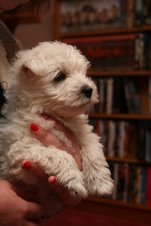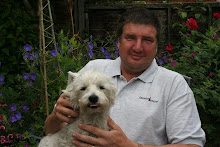It stays amazingly dry for a 7th consecutive day so that almost all our puddles are gone and it is possible to walk on the former 'sloppy patches' again. I cannot remember the last time I was able to say that and I am reduced to carrying water to the geese in the 'Curver' buckets in a wheel barrow to top up their temporary pond as they look at me a bit sideways wondering where all their nice puddles vanished to. The wind, though, swings round to the NE and turns bitterly cold, putting me off the re-start of pond digging and dissuading both of us from the hedge cutting task.
I decide it is time to find a proper home for my fallow deer skulls. I have three, all found in Challock Forest near Ashford in Kent. One is a fully mature 8-9 year old who had been the Master Buck at his final rut and who we also know was a white-phase deer. The huge majority of the population in Challock are what they call 'black phase', as dark as a dark brown Alsatian dog and with none of the 'Bambi' spotting you see in normal book illustrations. Just one or two are pale sandy coloured, almost white. They are not albinos, they are just 'white phase' and may be the result of escaped white bucks getting into the forest from nearby deer parks.
These boys live for the day when they will be big and strong enough to hold the rutting 'stand' and serve as many does as they can before exhaustion has them kicked off by younger pretenders. If they make it at all, they will make 'Master Buck' aged 7,8 or 9 but when they are in rut they do not eat or drink, they are so focused on the ladies. It can be so exhausting for them that when they are finally defeated and pushed off the stand, they are spent. They go off for several days lie down or sometimes collapse and die, which is what happened to this guy in 2005.
We know this because the then Park Ranger (Steve P) saw it happen and then tracked and found the corpse and was able to show it to us, a group of people out on an expert-guided deer walk. He warned us that it was by then badly rotted and maggoty but we could see it if we felt up to it. I simply quietly remembered where it had been in fairly deep cover and nipped back a couple of months later to collect the now nearly clean skull. I re-buried it in the compost at home and let my own maggots finish the job of cleaning it.
I mounted it on a piece of hardwood and it hung for a several years in our hallway. Rather disrespectfully we named him 'Rudolph' and even hung Christmas Decorations on him the first year but then we had an attack of conscience and respect for the magnificent lad so we just admired him 'clean' there-after and left him unmolested.
Such 'trophies' are rare indeed and I only got this one because of Steve's tip-off but my luck held and I made an even more amazing find the next year just by spending a lot of time in the forest and diving off the beaten tracks when out walking the dogs, and exploring the thicker, wilder stuff. I said before that only the Master Buck can hold the stand and battles hard with any young challengers. They are reduced to messing about on the periphery, practising mock-fights with each other. This even applies right down to quite young fawns, who amuse you by playfully head-butting each other and bleating like little goats. As the boys get older, coming up to 4-6 years old this practising can get quite violent and purposeful. The bucks can injure or even kill each other.
My second 'trophy' was just such a situation - two even aged bucks had crashed into each other, the front lower prong of one buck smashing through the top of the eye socket of the other and the two sets of antlers locking together with fatal results. I do not know whether the damaged guy was knocked unconscious or what, but the two bucks remained locked till they were both dead, decomposed and the limbs and bodies pulled apart and scattered by, presumably, foxes and other scavengers. All that was there when I came to the place were the two skulls still locked together and a few leg bones lying around at some distance. Rather ghoulish, maybe but imagine my thrill at being able to gather up the paired skulls and bring them home. By then I was doing the guided deer-walks for the Friends of King's Wood (Challock Forest) myself, having taken over the task from Steve so I was able to produce these impressive trophies to show the public at each walk.
Well, now the 'trophies' are back on display, having come over here in the 2CV trailer and been stuck in the Tígín ever since, slung over a rafter. Here they attracted lots of fascinated comment and attention from the builders and tradesmen who call them "antler-horns" in these parts. You do get Fallow Deer in Roscommon but I have not yet managed to locate any. Incidentally, they are the only deer in the British Isles who show the bone 'webbing' or palmation between the prongs of the antlers. First year deer like the one in my black-phase picture above have just a pair of prongs and are called 'prickets'. Antlers are shed in May and re-grow each year. In the following years the bucks add more prongs and then as they hit 5-6 they start with the palmation till at year 7-8 they have a magnificent spread of fully webbed antlers. Incidentally they are also the only deer where you refer to males as 'bucks' (not stags) and the females as does rather than hinds. And when I say 'magnificent' don't get any ideas about massive, heavy, Monarch-of-the-Glen animals - even at their biggest, fallow bucks are no taller than a Great Dane or Irish Wolfhound at the shoulder, and the big spread of antlers is probably no taller than 30" and no wider than that either.
I love these deer and they have given me no end of pleasure stalking them with the long telephoto, and 'showing them' to the public. I miss them.
Thursday, 21 February 2013
Rudolph Re-Mounted
Labels:
black phase,
bucks,
Challock Forest,
Curver buckets,
does,
fallow deer,
KIngs Wood,
palmation,
White Phase
Subscribe to:
Post Comments (Atom)








No comments:
Post a Comment